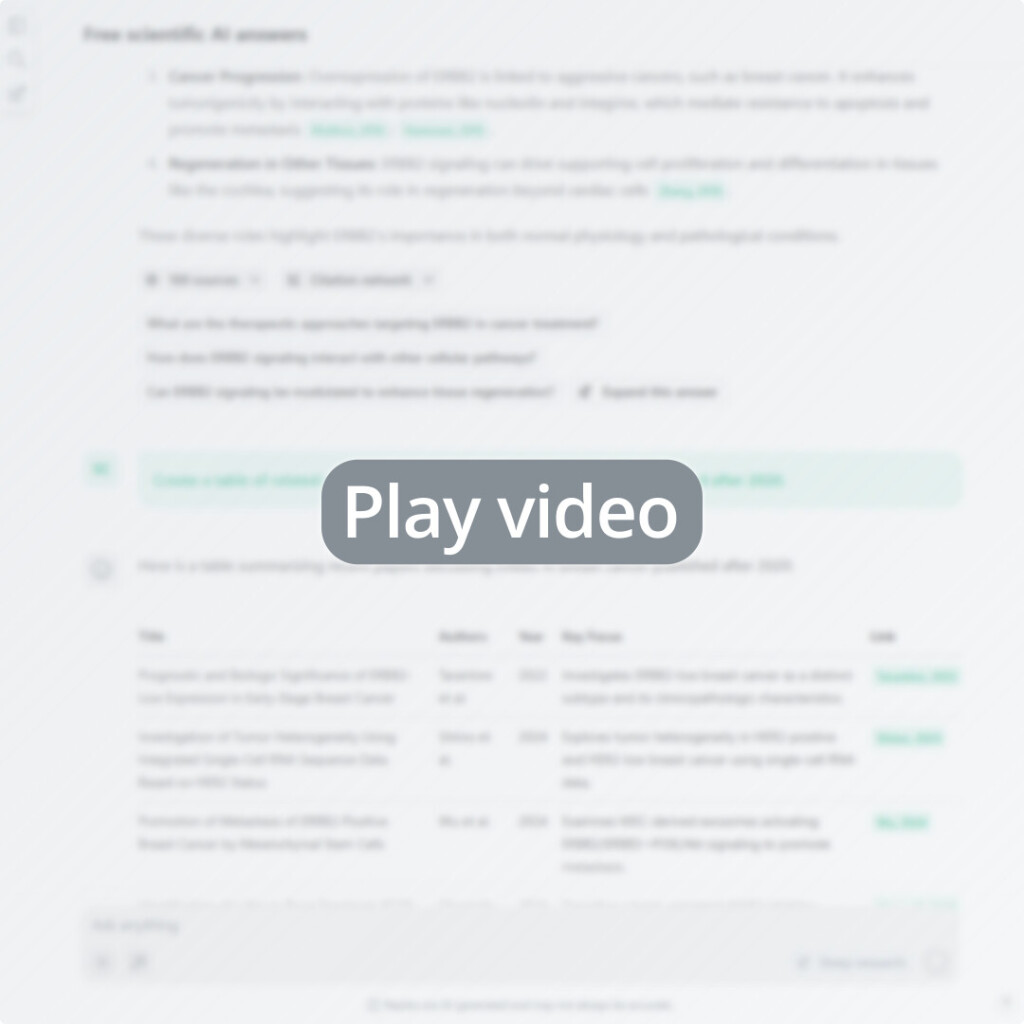AI technology holds great potential for scientific progress. AI tools support scientists in generating hypotheses, processing and analyzing data, and other tasks. Thus, many researchers use AI-based research tools for working with literature and writing support. Recent classification of AI usage for manuscript writing classifies the use of AI based on the type of work performed.
The extent of AI usage is typically decided by a researcher or a team of researchers based on the tasks to be performed, standards within a research group, an institution, a publishing house, or an understanding of the ethical norms of a particular researcher using an AI tool. As of today, the use of AI tools in research grows at a tremendous speed.
We believe AI research tools can provide great support to scientists and help accelerate research. In this tutorial, we will address how researchers may ethically and transparently disclose their use of AI and provide a Use of AI disclosure template accordingly.
Questions of AI ethics in scientific writing
Today, a substantial number of scientists use tools like scienceOS to assist with creating scientific content. This raises ethical questions about the intellectual impact of authors, privacy issues, the scientific integrity of such approaches, and biases engrained in the AI training data. Additionally, AI-generated texts and texts generated with AI support raise questions about intellectual property ownership. These and many other ethical questions are one of the main factors preventing scientists from using AI tools.
As AI tools appear to become a standard support tool for the research process, stigma around AI usage should be addressed by transparency about this topic: clear guidelines, training programs, and maybe even comprehensive legal frameworks are essential to ensure the ethical use of AI in academic research and education.
While many of these approaches are currently under development, transparently disclosing the use of AI tools in research is something scientists can and should already do. It is an immediate first step toward fostering trust, accountability, and ethical integrity in academic work.
Guidelines for disclosing the use of AI
Research organizations are taking the initiative to develop guidelines for disclosing AI usage. For example, the International Association of Scientific, Technical & Medical Publishers (STM) suggests the following steps to journals for defining an AI usage guideline for manuscripts:
- Decide which types of AI use are allowed when authors prepare manuscripts, and make these policies clear and accessible.
- Specify which allowed uses of AI must be disclosed during manuscript submission.
- Specify which allowed uses of AI must be disclosed in the manuscript itself and appear in the published version.
- Give authors clear instructions on how to follow the AI use and disclosure policies.
Today, most publishing houses provide guidelines on how to declare AI usage. Below, you will find a brief overview of AI disclosure policies by the journals Nature and Science. Yet, due to the rapid advancement of AI technology, these rules may change quickly. It is important to review the guidelines before the submission of a manuscript.
The journal Science requires authors to add information about ‘AI-assisted technologies’ in the cover letter and the acknowledgments section, in addition to providing detailed information about AI usage in the methods section. Science further requires sharing the tools, versions, and, importantly, full prompts.
The journal Nature requires some LLMs to be documented in the Methods section. However, ‘AI-assisted copy editing’ does not need to be declared. Nature also underlines that humans are accountable for the final version of the text, including a mutual agreement from all the authors of the manuscript. Springer Nature, the publisher of the journal Nature, has a separate policy for the peer review. While they are exploring the use of AI for the peer review process and request reviewers to transparently state AI tools usage, they ask not to upload manuscripts into generative AI tools. The Nature journals may also make use of an internally developed Springer Nature AI tool for certain editorial processes.
Recommendation for disclosing AI usage
We recommend specifying how and why you used scienceOS, whether for editing, translation, research, or any other purpose – include the version and link in your description (e.g., scienceOS (May 2025 version), https://www.scienceOS.ai). We further recommend that you add a transcript of all your interactions as an appendix by using the copy chat function or that you add examples of your queries by using the copy answer function. This helps demonstrate your commitment to transparency. (Here is an example of how scienceOS was previously referenced in a paper.)

Copy answers and chats. A short video showing how to copy individual answers or the full chat transcript for further use in other tools or for documenting and disclosing the use of scienceOS.
For this purpose, we developed a flexible template that contains placeholders and a range of options to quickly disclose your use of scienceOS or another AI tool. (You can also download the template here.)
Use of AI disclosure
During the preparation of this manuscript, the authors used scienceOS, accessed between [START DATE] and [END DATE] via the [FREE | PAID] service at www.scienceos.ai. AI assistance was employed for one or more of the following purposes [SELECT ALL THAT APPLY AND ADD ADDITIONAL USES]:
- Conducting literature searches on specified topics
Example prompt: “[PROMPT]” - Identifying gaps in the existing literature
Example prompt: “[PROMPT]” - Suggesting complementary citations relevant to specified topics
Example prompt: “[PROMPT]” - Drafting outlines for review sections based on selected papers
Example prompt: “[PROMPT]” - Support in the planning of experimental designs
Example prompt: “[PROMPT]” - Support in the interpretation of results
Example prompt: “[PROMPT]” - Summarizing cited works
Example prompt: “[PROMPT]” - Drafting and/or writing manuscript sections
Example prompt: “[PROMPT]” - Assisting with abstract writing
Example prompt: “[PROMPT]” - Refining, correcting, editing, and/or formatting text to improve clarity
Example prompt: “[PROMPT]” - Generating or editing schemes, diagrams or other figures
Example prompt: “[PROMPT]” - Assisting with reference list compilation
Example prompt: “[PROMPT]”
All AI-generated suggestions provided by scienceOS were critically reviewed, selected, and, where necessary, revised by the authors. Final interpretation, analysis, and presentation remain the original work of the authors.




